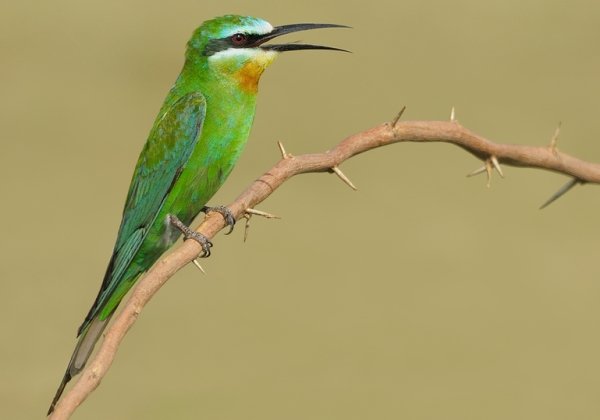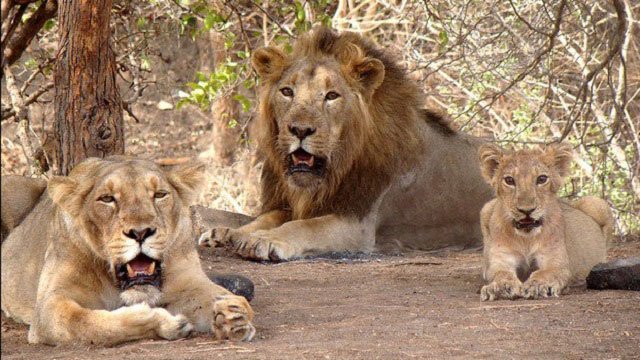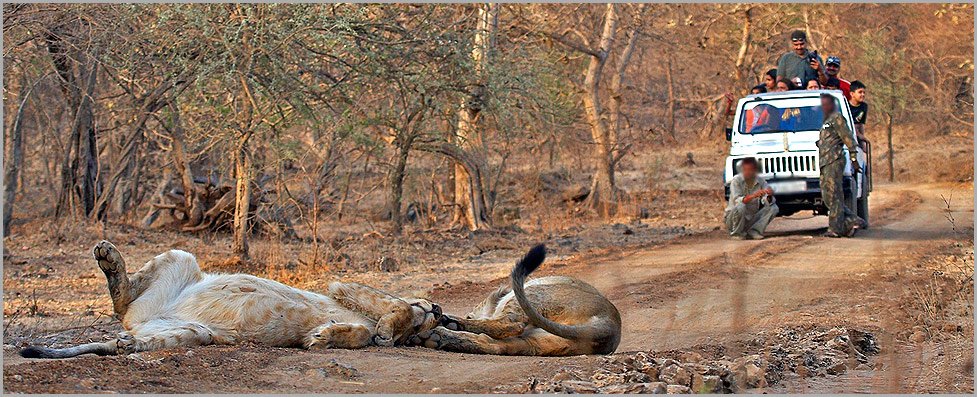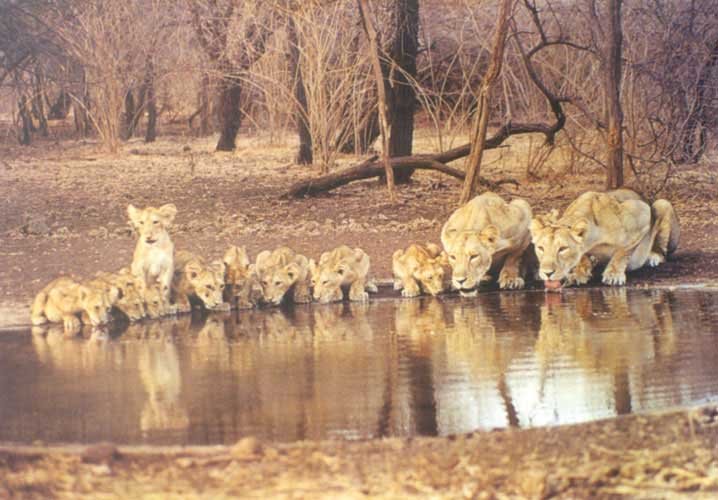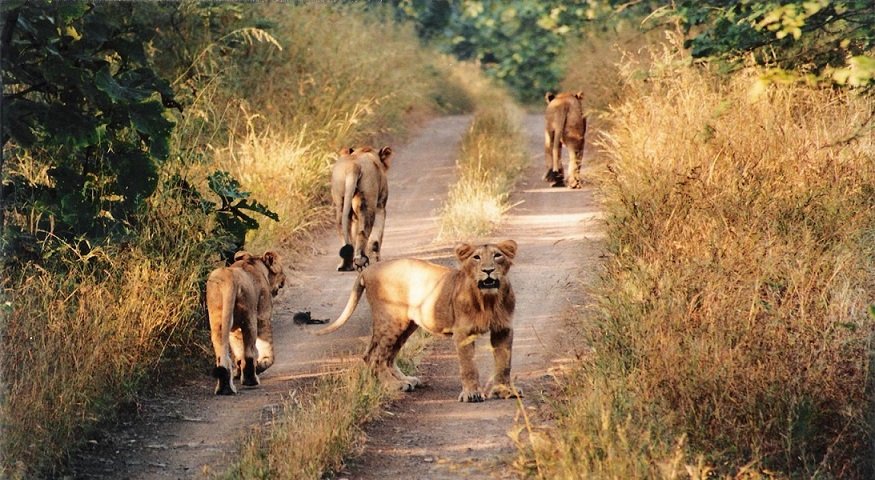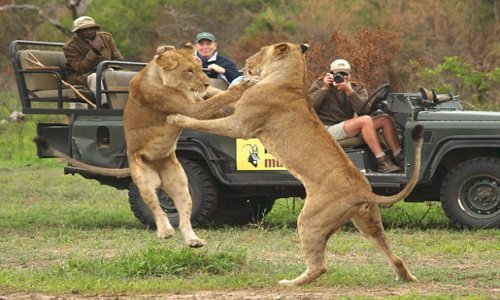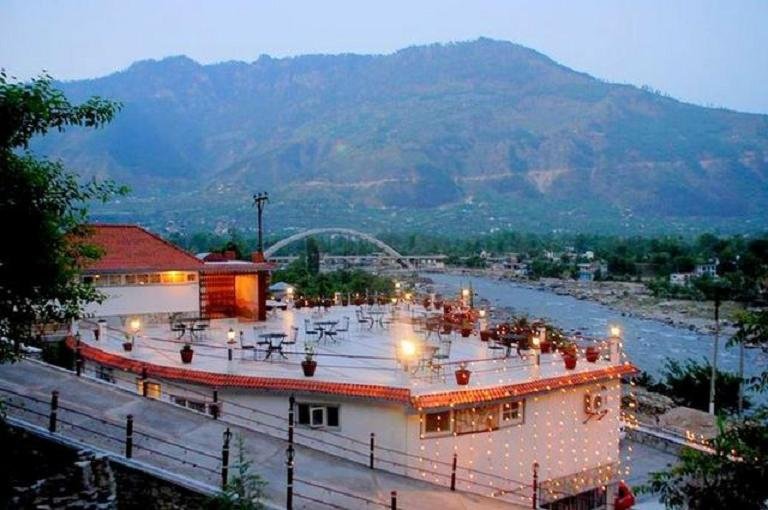Gir
Highlights
Gir National Park & Wildlife Sanctuary is the last abode to the surviving population of the Asiatic Lion in the wild. The park comprises 1412 sq. km of deciduous forest interspersed with semi-evergreen and evergreen flora, acacia, scrub jungle, grasslands and rocky hills. Fed by perennial and seasonal rivers and streams, the sanctuary has large water bodies like the Kamleshwar Dam that are good for marsh crocodiles, reptiles and birds.
Gir has about 400 lions and 300 leopards, making it as one of the major 'big cat' concentrations in India. Deer such Sambar & Chital, Antelopes such as Blue Bull, Four-horned antelope, Indian gazelle and Wild Boar are in abundance in Gir. Jackal, Striped Hyena, Jungle and Rusty-spotted cat, Langur, Porcupine, Black-naped Hare are among the other mammals of Gir.
Gir has a large population of marsh crocodile, which is among the 40 species of reptiles and amphibians recorded in the sanctuary.
The park checklist has over 250 species of birds. Rare species such as Lesser Florican and the Sarus Crane are recorded in the grasslands along the periphery of the sanctuary.
In Gir you touch the history of India before humanity itself. Before monuments, temples, mosques and palaces. Or rather, a history as humanity was emerging, when humans coexisted with lions, before the former had overrun the continent (and the world) and pushed the latter to the brink of extinction.
Many come to Gir because, outside of Africa, it is the only place with wild lions. But to truly experience Gir and the lions, you must explore their natural habitat, with everything from tiny wild birds, not easily seen, but heard singing in the forest canopy, to crocodiles floating in the marsh waters.
Driving around, you are uncommonly aware you are in someone else's territory. You stay in your vehicle because you are in the home of lions, leopards, hyenas, crocodiles; you remember that humans do not rule the world, and however "advanced" we think we are, most of us would not survive very long on our own in a place like Gir.
That is not to say that all humans are out of place. The local Maldhari community has lived here for generations and coexists magnifcently with the wilderness. They sustain themselves by grazing their livestock and harvesting what they need from the forest. The sizeable portion of their herds lost to lions and other predators is considered prasad, offered in exchange for living in another's homeland.
How many of us are aware, let alone as concientious as the Maldharis about the impact of our lifestyle on other species? How can we be, if we so distance ourselves from the habitats that are ravaged to feed our material appetites? When you visit Gir, try to see the Maldharis not with nostalgia for a picturesque past, but as crucial teachers for a better present and future. You don't have to be a shepherd living with wild lions to learn from their way of life. Ask yourself why we have reached the point where National Parks like Gir are neccessary; what happened to these lions who used to inhabit everywhere from Greece to Bangladesh. If you begin to understand the deeper implications of these questions, you will return home, whether home is a hut in the countryside, or a high-rise apartment, whether in Mumbai or Berlin, charged with new inspiration for evolution in your own life.
Gir is a place that deserves time and involvement. Your chances of spotting wildlife in a few hours is small, especially in the middle of the day; to truly experience the wonders of the Gir forest, and hopefully see a wide variety of its diverse wildlife, three or four days is recommended, particularly with a knowledgeable guide. This will vastly improve the depth of your visit. Contact the Park for information about hiring a guide (phone number below.)
While Gir is most famous for its lions, the park is one of the most diverse places in Gujarat, both in flora and fauna.
Flora
Most of the area is rugged hills, with high ridges and densely forested valleys, wide grassland plateaus, and isolated hilltops. Around half of the forested area of the park is teak forest, with other trees such as khair, dhavdo, timru, amla, and many others. The other half is non-teak forest, with samai, simal, khakhro and asundro jambu, umro, amli, vad and kalam; mostly broadleaf and evergreen trees. The river Hiran is the only one to flow year-round; the rest are seasonal. There are also areas of the park with open scrub and savannah-type grassland.
Deer and Antelope
This variety of vegetation provides for a huge array of animals. The most-sighted animal in the park, the chital, or Indian spotted deer, inhabits the dry and mixed deciduous forest, with a population of over 32,000. The more reclusive sambar, the largest of the Indian deer species, weighing 300-500 kg, lives in the wetter western part of the park. Both the sambar and the chausingha, the world's only 4-horned antelope (chau= four, singha= horns), are very dependent on water, and rarely found far from a water source. Another one-of-a-kind is the chinkara, the only gazelle in the world with horns in both males and females. The fastest of the Indian antelopes, the blackbuck, also lives in Gir, but has a relatively small population here compared to Velavadar National Park (near Bhavnagar), as it prefers open grasslands to forests.
Wild Cats
Along with the famous lions, who number around 350, the park is also home to four other wild cats. There are around 300 leopards, though they are nocturnal and thus harder to spot. Of the three smaller wildcats, the jungle cat is the most widespread, and lives in deciduous scrub and riverine areas. The mysterious desert cat is almost never seen. The rusty spotted cat, previously thought to only live in the Dangs of southeast Gujarat, has only recently been found in Gir.
Other animals and reptiles
The top and middle canopies of the dry, mixed and riverine decidous forests are home to troops of hanuman langur monkeys. The striped hyena is usually seen scavenging alone in the grasslands and scrub forest, far more solitary than the African hyena. Wild boars rooting into the ground for tuber provide aeration of the soil. If you look closer, you may see smaller mammals like pangolins, pale hedgehogs, Indian hares, or grey musk shrews. The ratel or honey badger is renowned for its snake-killing exploits, earning it the “most fearless animal” title in the Guinness Book of World Records. Another snake-killer in Gir is the ruddy mongoose; the snakes they contend with include the common krait, russell’s viper, and the saw-scaled viper. The Kamaleshwar reservoir now houses the largest population of marsh crocodiles in the country. Other reptiles include the soft-shelled turtle, star tortoise, Indian rock python and monitor lizard (which grows to over 1.5 m long; don’t look for the lizards that live in your yard.)
Birds
Gir is also home to more kinds of birds than any other park in Gujarat, yet somehow is not known for its birdlife. While it may not have the half-million flamingoes found in Kutch during breeding season, Gir is home to over 300 species of birds, many of which can be seen year-round, from the Malabar whistling thrush to the Paradise flycatcher, from the crested serpent eagle to the king vulture, from pelicans to painted storks. The noted ornithologist Dr. Salim Ali said that if there were no lions here, Gir would be well-known as one of the best bird sanctuaries in western India.
The Asiatic Lion
Until the early 19th century, Asiatic lions roamed an immense area of South and Southwest Asia, as far east as Greece and as far west as modern Bangladesh. As humanity has lived in this region for millennia, people coexisted with lions for thousands of years, but in the last few centuries, the growth of the human population has come at the cost of the lions’ habitat. Like the Bengal Tiger and the Asiatic Cheetah, lions saw a dramatic decline in population as their preferred habitat of grasslands and semi-forested areas became overrun with humans. Beyond just habitat reduction, though, once guns arrived and became widespread, from 1800-1860, nearly all the lions remaining outside Gujarat were hunted and killed. The last Asiatic lions in India outside of Gir forest were killed in 1886 at Rewah, and the last wild lion sighted the world outside Gir was in Iran in 1941.
In 1901, Lord Curzon was offered to be taken lion hunting while visiting Junagadh. Noting that these were the only lions left in Asia, he declined, and reportedly suggested to the Nawab of Junagadh that it would be better to conserve the lion population than to hunt it. The Nawab began what was probably the first institutional wildlife conservation effort in India and one of the earliest in the world (though various human societies have been operating in ways that conserve wildlife throughout the ages), banning all lion hunting entirely. From a population reported to be as low as 20 in 1913 (considered exaggerated by some wildlife experts, noting that the first official census in the 1930s found over 200 lions), the lions have rebounded to now number 359 in the most recent census of 2005. This is due almost entirely to the Nawab’s conservation efforts, and the Indian Government’s post-independence ban on lion killing in 1955.
Though the lions have maintained a small healthy population, their habitat continues to shrink, and they remain a critically endangered species. The Gir forest area, which covered over 3000 square km in 1880, was reduced to just over 2500 square km by the mid-20th century, and only 1400 square km today. Of that, a mere 258 square km make up the National Park itself. While the population has grown due to successful conservation programs in the park, the park is too small for the number of lions it now houses, and lions are straying outside to seek further living space, often not surviving well in the other areas.
Locally called sher or sinh, the Asiatic lion is over two and a half meters long, weighs 115 to 200 kg, and can run short distances at 65 km/h to chase down the sambar, chital, nilgai, and chinkara that are its preferred prey. However, when not hungry, it will never attack an animal; after a lion makes a kill, it will gorge itself on up to 75 kg of meat, and then not worry about eating for a few days, so it is not unusual to see a well-fed lion lounging calmly beside a herd of grazing deer. The lions prefer open scrub and deciduous forest areas, and are very bold, not shy around humans. So even if they seem tame or timid, do not approach them, they are still very powerful wild animals.
Humans and Gir
Humans’ relationship with Gir is long and mixed. The very existence of a sanctuary is testament to the dire need of a protected area, given the rapid expanse of civilization that has completely taken over everywhere else around (see above section on the lion.) After India’s independence in 1947, the rapid push for food independence led much wild grassland to be converted to agriculture. This had major effects on the wildlife of Saurashtra, but also on the human population; as large-scale farming spread across the region, those peoples who traditionally herded livestock in wild grasslands were pushed further and further into much more limited regions. Faced with this situation, the Maldhari community migrated into the Gir forest despite obvious dangers and a total lack of infrastructure, in order to maintain their way of life. When the park was declared, they were allowed to remain and continue their traditional practices; in fact, Gir forest is now virtually the only area where the Maldharis still live as they wish.
As herders, they shepherd their cattle and buffalo around the park, which opponents (including the Forest Department) claim overgrazes the area and makes it harder for the wild deer, antelope, and other species to graze as well. However, recent studies have shown that between 25 and 50% of the Gir lions’ diet is made up of Maldhari livestock, meaning that the presence of the Maldharis is vital to the survival of the lions. In fact, the Maldharis apparently consider livestock lost to predators as payment for living in their territory. Furthermore, as vegetarians, the Maldharis are never poachers.
Compare this attitude with that of farmers near the park, who have killed many lions who they say "encroached on their land," not realizing that they have in fact encroached on the lions' land, and the lions of course cannot know where people have drawn the park boundary line. The humans who do know this, however, often graze cattle illegally inside the park adding further pressure on the ecosystem from the 97 villages within 5 km of the park. For these reasons and many others, the Gir forest and the critically endangered lions are under increasing threat from human activity.
Tourism itself is a growing threat to Gir. Clearly, the genuine visitor is beneficial, but tens of thousands of people visit the park every year simply as an afterthought to their trip to Somnath or Junagadh, stopping in for a few hours to snap a photograph of the lions in captivity. These visitors create a huge demand for infrastructure but do little of benefit to the park or the lions, not even staying long enough to really experience it or learn much at all. The presence of several temples inside the park also puts strain on the ecosystem, as visitors to them also demand accommodation and infrastructure that often conflicts with the park’s conservation goals, leading to great controversy and political tension between park management and temple management.
While all of these threats may have distinct immediate origins, they are in fact all the result of having reached a point where wild natural environments are confined to extremely limited areas, and human civilization, industry and economy has overtaken everything else. The problem is not, in fact, that the lion population has grown “too big for the park,” but that the park is far too small for the lions. As a visitor, let this be an opportunity to spark your imagination on the question of shifting the priorities of humanity towards re-integrating ourselves with the rest of life.
For shorter visits, the Gir Interpretation Zone, at Devalia, 12 km west of Sasan Gir, has some lions in captivity, but this is not the same as visiting them in the wild. After all, to see a lion in captivity you can visit a local zoo; come to Gir to see them in the wild. Entry fees for the Interpretation Centre (different from the park itself) are, for Indians Rs. 75/- Mon.-Fri, Rs.95/- Sat.-Sun, Rs. 115/- on Holidays and for foreigners US$20, payable only in rupees.
How to Reach Gir National Park
Gir National Park attracts large number of tourists to witness the Asiatic lion, as this is the sole place all across the world where these creatures are presently found. Once extinct, numbers have been recovered owing to the conservation efforts. The Sanctuary is open for tourism from 16th October to 15th June every year.
Junagadh is perhaps the best approach to the park. The railway station in Junagadh receives trains from different cities like Ahmedabad and Rajkot and other major cities. Then, from here it takes approximately one and half hour to reach Gir National Park.
From Rajkot-On reaching Rajkot Railway Station or Airport you can take a cab or bus and to reach a Limda chowk. There are a number of privately operated that go to Junagadh at frequent intervals. Junagadh is nearly 105 Kms from the city Rajkot and it takes nearly 2 and a half to 3 hours to cover the distance.From this point you have two options. First one is either you take a bus from gate number 11or 12 to Sasan Gir or travel by taxi that is accessible bang opposite the taxi stand. The taxi will take nearly one and half an hour and will charge reasonably and will drop you to Sasan Gir.
From Somnath to Gir National Park: Road Distance or the driving distance from the Gir National Park to Somnath is approximately 50 Kms and it takes nearly 1 hour to cover this distance. GSRTC buses and quite a few private buses ply between both the cities and take you directly to Sasan Gir Forest.
From Diu To Gir Park: Diu airport is closest to the Gir National Park. From here you can hire that are present just outside the airport which will take you to Sasan Gir. Sasan Gir is nearly 110 kms airport of Diu and takes approximately 2 hours to cover this distance. If you have a late afternoon flight it is better to take a halt at Diu or can visit Somnath Temple which is nearly 80 kms from Diu and the road too is good except in little patches. It just takes an hour to reach Somnath from Diu. Next morning you can move on to Sasan Gir which is just 40 kms from here and just takes half an hour to cover this distance.Some other routes to reach Sasan Gir by road is from Keshod which also has an airport and is 45 kms, Veraval is 40 kms away, Junagadh is 55kms, Rajkot is 160Kms, Ahemedabad is 410Kms. The closeby railway stations are Sasan which is 0 Kms and Rajkot which is 160 Kms.
If you can't afford a taxi there are frequent buses that are playing throughout the day. The park is easily accessible from the beautiful beaches of Diu which is about two hours drive don't want to take a taxi, pubic buses run regularly to Sasan Gir from both places during the day. People prefer private buses as it conveniently drops them to the Guest houses you want to reach. So in this way they are more convenient than the buses. No prior booking is required as the buses are available on any part of the day. So, come and enjoy the beautiful flora and fauna of Gir National Park and take home some of the most treasured moments back home.
Gallery
Related Package
No Package available
Related Hotel
Reviews
Excellent
4.6 / 5.0
90% recommend this package
Score Breakdown
- (58)
- (132)
- (89)
- (58)
- (9)
Average Rating For
- Cleanliness 4.5
- Service 4.5
- Comfort 4.2
- Condition 3.8
- Neighbourhood 4.4
